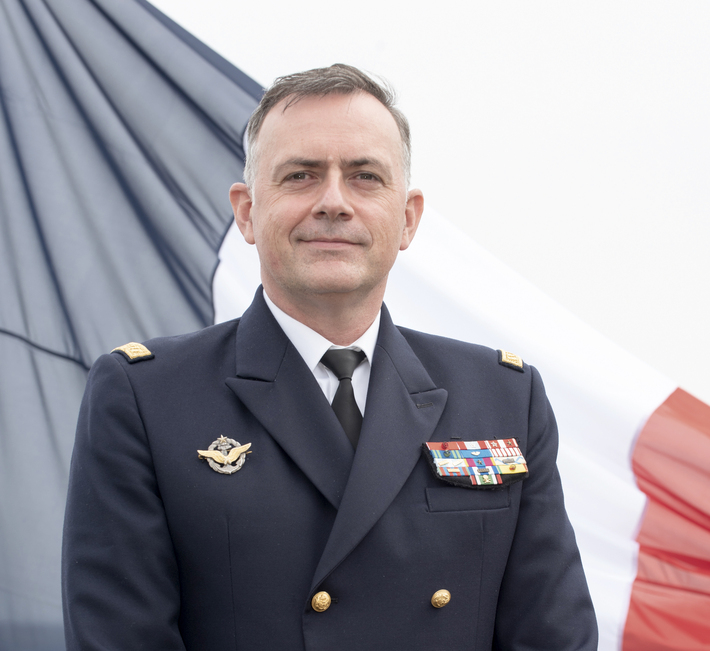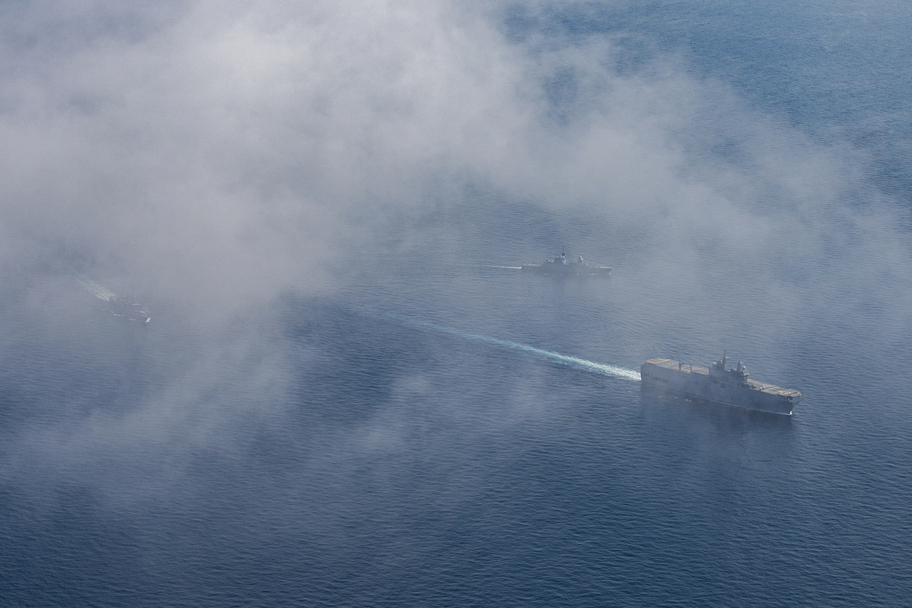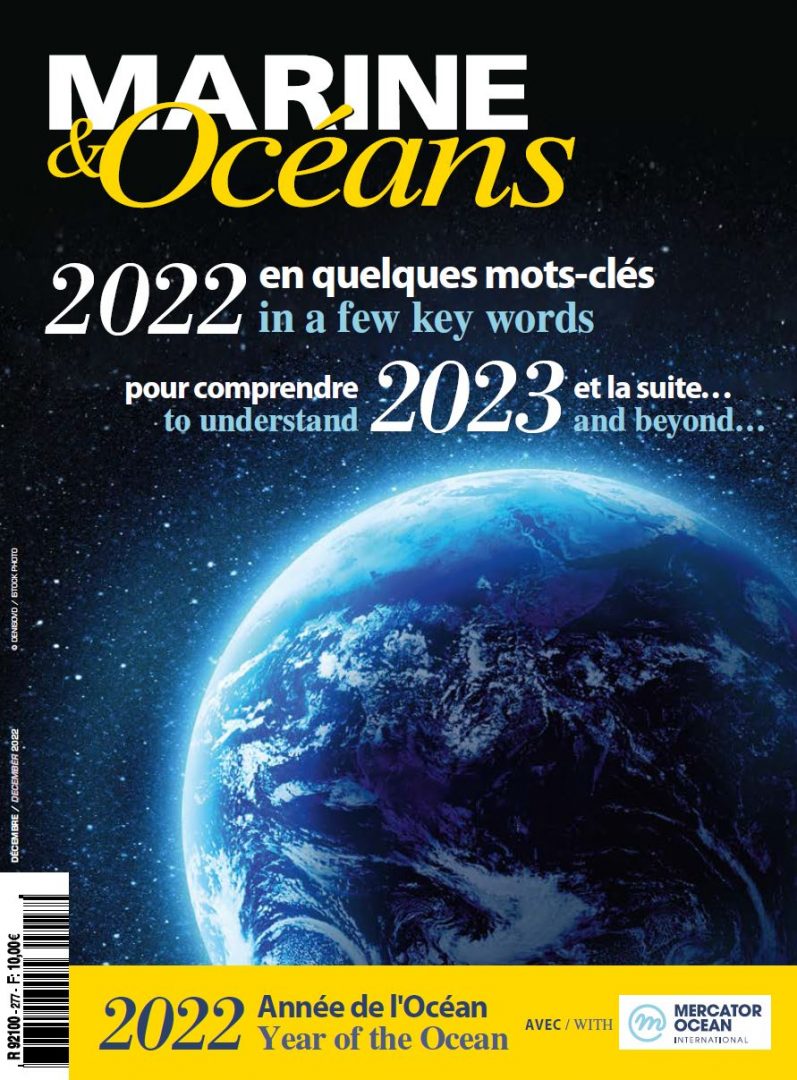
“The hypothesis of naval combat is thus back
on the agenda and the French Navy is getting ready to face it.”
By
Admiral Pierre Vandier,
Chief of Staff of the French Navy
For about ten years now, the world has been facing a deterioration in the geopolitical context with a return of interstate competition, primarily crystallised within common spaces (cyberspace, exo-atmospheric space, aero-naval space) and with a growing recourse to hybrid and latent modes of action combining the regular and the irregular, the military and the civilian, communication, and ambiguity. These actions complicate the attribution of aggressions and blur the interpretation of intentions.
In terms of naval forces, there has been a massive rearmament effort since the late 2000s that can be interpreted as a symptom of this deterioration. Historically, it is indeed the perception of a threat that provokes the arms race, and not the opposite. It would be a mistake to analyse the size of a fleet without first considering the will to operate it. This would be confusing the order of the means with that of the ends. However, if we look at things more closely, this naval rearmament can be observed in all theatres of operation and obeys various motivations:
– As a symbol of power, it is usually developed on a regional scale, in a given area where countries compare themselves or seek to protect from a dominant power, they consider aggressive. Today, naval rearmament is also developing on global scale through the acquisition of high seas fleets consisting of capital ships, in the framework of a much broader competition for world leadership.
– As a sign of prestige, a powerful fleet is a vector of influence and naval diplomacy, a concept dear to Hervé Coutau-Bégarie[1], which includes providing aid to countries affected by natural disasters, protecting nationals in the event of a crisis, or which may be used as an instrument of intimidation or even coercion.
– As an asset for the preservation of economic interests, naval rearmament is the logical consequence of globalisation, which has essentially proved to be a maritimisation process (commercial maritime flows, underwater cables, fishing, and mineral resources, etc.). In this respect, the still unexploited potential of certain marine resources, and the vulnerabilities and dependencies revealed by the Covid crisis, suggest that this component constitutes a major and lasting trend.
– As an instrument of constraint on supply flows or for the purpose of safeguarding a given area, the naval force allows to exert a high military pressure without leaving any trace on land. It can deny a naval force the use of its own capabilities and force it to remain in port. A strong dissymmetry in the development of two opposing fleets favours the use of the “fleet in being”[2] concept and, ultimately, forces the adversary to no longer consider confrontation as an option.
It should also be noted that the inertia and difficulty of developing a naval power requires the ability to anticipate a geopolitical context several decades in advance, to define a political ambition to meet it and to maintain a trajectory to achieve it. All countries endowed with a naval industry must deal with the strengths and the constraints of their industrial tool. As Coutau-Bégarie said, “maritime policy cannot be separated from naval strategy… A maritime policy that only focuses on its civil dimension is incomplete; in a truly integrated maritime policy, the civil and military components mutually support each other”[3].
The legitimate need to protect strategic supplies or to counter all forms of predation does not necessarily imply aggressive behaviour. But the concentration of naval forces in a crisis context and the disinhibiting temptation to capitalise on a favourable balance of power can increase the risk of miscalculation and missteps at sea[4]. At worst, such disinhibition may even result, for some parties, in the deliberate and cynical encouragement of sporadic and controlled confrontations for immediate gain before they relieve the pressure.

The acceleration of the Mercator strategic plan
After three decades of relative stability, the sea is no longer the sanctuary it once was to support ground operations. In response to this challenge, the French Navy places its action in the acceleration of the Mercator strategic plan. It already has solid assets, such as the culture of autonomy and innovation of its sailors, their daily commitment in operations, their capacity to work in joint forces and in international coalitions. The changing context forces us to reconsider some of our existing modes of action as we were confronted with a low spectrum threat. The destructive and rapid nature of naval combat calls for a diversification of our approaches to adapt to the increasing intensity of interactions with our competitors.
The POLARIS exercise, which brought together 6,000 French and foreign troops, including 4,000 sailors, at the end of November, was designed in this respect. Built on high spectrum actions using advanced capabilities on both sides, POLARIS allowed to plan and assess new types of action, adapted to the current environment. The Mercator project also aims to optimise equipment, by attempting to partially avoid the long timeframe of armament programmes (10 to 20 years) in order to identify “leverage effects”, such as the adaptation or improvement of existing platforms with new sensors or new effectors (drones, directed energy weapons, etc.). The complete integration of new technologies (new space, digital, drone, robotics, artificial intelligence) should also help us to make a difference.
The hypothesis of naval combat is thus back on the agenda and the French Navy is getting ready to face it, as a guarantee of its credibility in a phase of contestation and as an ambition for superiority should direct confrontation arise. However, naval rearmament does not inevitably bear the seeds of a future confrontation. Dialogue and diplomatic action will always help to avoid the worst. The fact that states are becoming increasingly aware of the global dimension of maritime issues, particularly those related to resources and climate, also encourages cooperation, as demonstrated by our ongoing experiment with the Indian Ocean navies in a forum currently chaired by France[5].
As a result, the scope of action of the French Navy is not limited to countering the uninhibited behaviour of our competitors. It is much broader and includes a strong commitment to environmental security, as threats to biodiversity and the effects of climate change are becoming stronger every day (e.g., the fight against IUUF[6], against pollution and support for scientific missions). Its field of action also includes a particularly important support for the development of the blue economy, such as securing maritime routes by fighting against illegal activities, contributing to the development of dual high technologies, and protecting the assets of our EEZs[7], including the seabed. The units of the French Navy dedicate their daily action to all these missions.
–
[1] Hervé Coutau-Bégarie, Le Meilleur des ambassadeurs, théorie et pratique de la diplomatie navale, Economica, 2010.
[2] A fleet that exerts a decisive influence without leaving port, due to the potential threat it constitutes, forcing the opponent to set up means to deal with it.
[3] Hervé Coutau-Bégarie, L’océan globalisé, géopolitique des mers au XXIème siècle, Economica, 2007.
[4] On 30 June 2021, following an incursion by the British frigate HMS Defender into Crimean territorial waters, which was being harried by Russian aircraft, President Vladimir Putin declared: “Even if we had sunk that ship, it would still be hard to imagine that the world would be on the brink of a Third World War”.
[5] Since 2021, the French Navy has chaired the Indian Ocean Naval Symposium, which brings together 25 countries bordering the Indian Ocean (India, Pakistan, Iran, etc.). The symposium took place in La Réunion in July 2021 on the issue of environmental security.
[6] Illegal, unreported and unregulated fishing
[7] Exclusive economic zone. With 11 million km2, France possesses the world’s second largest maritime domain, of which a significant part of the resources has yet to be discovered (fishing, biotechnology, rare metals, hydrocarbons, molecules for the pharmaceutical industry, etc.).


